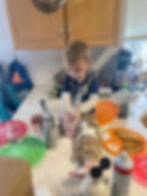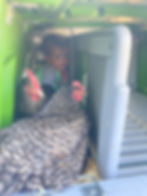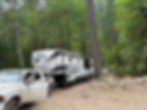Yol Bolsun: May there be a Road
- Preston Clark
- Sep 8
- 6 min read
Hyrum is 8 years old. We’ve known he was autistic since he was around two. Brittney was quick to sense something wasn’t right and had him tested. Some of the doctors commented on how perceptive she was to recognize it so early.

At first, he was a very mild baby—easy and not prone to much crying. The biggest concern we had were sudden high fevers and seizures that terrified us.
As he became a toddler, he started having intense crying fits where he’d hold his breath, turn blue, and then pass out. That’s when he’d finally breathe. It was terrifying.

Early Rigidity and the Start of ABA
Brittney would remember the timeline better, but I recall that around age four or five, we began noticing signs of rigidity. Unlike Eden at that age, Hyrum wouldn’t come to the table, get in the car, or join in family activities. Trying to coax him would often trigger a full meltdown—and sometimes, he’d stop breathing.
Around five, we began ABA therapy. He hated it. Just getting him through the clinic door sometimes took up to an hour. When he came home, he’d be so anxious he’d chew on his arm and be inconsolable for days. His arm became a huge cracked mass of inflamed skin. Almost like a heavily calloused foot.
We switched to in-home ABA. That helped a little—at least we didn’t have to fight to get him there. But Hyrum still struggled. Early on, he sang little songs like:
“Go away, scary Maddie, go away…”
To himself over and over in repetition, almost like he was soothing himself with it.
Maddie was his therapist at the time.
It was hilarious in a way, but also a clear reflection of his anxiety.
They rotated therapists often, trying to find a match. Only one ever made progress, but she was promoted and no longer available. Looking back, we realized she hadn’t really done “therapy”—she just played with him. And that’s what Hyrum wanted. If you played, he was calm. If you gave demands, he fell apart.
Eventually, the program owner worked with him personally. After a few weeks, she told Brittney:
“In my 20+ years, I’ve only met one other kid like him. And we couldn’t help that child either.”

The Beginning of PDA and Understanding
That’s when we first heard the term PDA—Pathological Demand Avoidance. It’s not formally recognized in the U.S., but it is in other countries. We worked with several state-provided specialists. Many were wonderful, but the consensus was the same: Hyrum didn’t respond like most autistic children.
One of the specialists from the state told us a little about PDA. The thing that stands out clearly to me was her warning that he would stop using the term mom or dad. He would call us only by our first names. And sure enough within six months of her telling us that he completely stopped calling us, mom and dad.
Brittney dove into research. We met other parents of autistic kids, which was eye-opening. While many had difficult lives, few experienced the constant intensity Brittney faced.
With Hyrum, there’s no pause. From the moment he wakes to the moment he sleeps, he requires full-time attention. He can hurt himself or others, destroy things, or make unimaginable messes. There’s no such thing as relaxing. No timeouts. No breaks.
Emotional Cost and Daily Survival
Brittney’s emotional toll was immense. Hopelessness was her daily companion. She was constantly on the edge of breakdown, and sometimes over the edge. I had to physically hold her to keep her from collapsing during meltdowns or rush home when she called frantic and in a state of panic
It was brutal.
By age five, Hyrum’s meltdowns became violent. Brittney was constantly bruised. Emerson, our younger son, looked beat up—covered in Band-Aids. Evenings were my turn, and I wasn’t spared. Hyrum knew how to pinch and scratch with precision. Even our dog aged noticeably from the stress.


Our Only Refuge: The Outdoors
The only relief was the outdoors. We had a fenced yard, and if the weather was decent, Hyrum would play. But even outside, he needed constant supervision. He’d fill up our French drains with anything he can find, hurt our animals, or destroy things. He spray-painted all of our cars when he found a can of spray paint sitting around. Other times he would play quietly and then suddenly go make a disaster. You just never knew.
We tried to let Brittney rest inside, but she couldn’t relax knowing what might happen. ABA had been the only real break, and now that was gone.
No schools would take him. ABA-based autism schools weren’t a fit. Public schools said they were required to accept him, but warned he’d likely spend most of his time in a padded room.
So we had no choice but to homeschool him.



Two Complex Boys, One Exhausted Mom
Emerson, our youngest boy, had his own struggles—severe anxiety, likely ADD and ODD. We tried public school, but he never spoke to teachers or peers. He sat in the corner all day. After a year with no progress, we brought him home too.
Now Brittney was homeschooling two neurodivergent boys. While they could sometimes play together, they were also volatile. Fights would erupt in seconds, often ending in major meltdowns and physical danger.
Brittney journaled, prayed, studied, and tried to care for herself. But she lived in constant exhaustion and near-hopelessness. Her strength was beyond anything I’ve ever seen.
She’s a hero.
Most people never saw how hard it really was. Her love for our kids was deeper than her own survival. I’m still in awe of her.

Change Begins
I began taking more time away from work as we prepared to sell my business. This gave Brittney some relief, even if only by separating the kids or taking one with me for a few hours.
Eventually, financial pressures forced me back to work—I started roofing with my Dad. It helped us stay afloat, but Brittney was alone again with the boys all day.
By end of winter, just a few months after starting roofing, she said she couldn’t survive another cold season in our home. We decided to rent a place in St. George for the following winter, hoping the change would help Hyrum. I had no idea how I’d balance this with my job, but we moved forward in faith.
A Turning Point: “May There Be a Road”
As winter turned into spring things got calmer as he was able to play outside. Then summer hit early. It seemed with high temperatures. For the first time, Hyrum would not go outside during the summer. It seemed like this year he was more sensitive to the heat, and when he’s trapped inside, he becomes almost impossible to live with. That's why winter was so miserable for us. But now Summer had brought the same result.
It was about this time we realized our home was no longer a fit for him at all. Not just during the winter.
Work provided me with an opportunity to get away for a little over a week on a job in Northern Idaho in early fall. I was able to take my whole family.
While in northern Idaho, we stumbled on a study from Australia: a boy with a similar autism profile showed marked progress when placed in constantly changing environments. In their case, they backpacked across Africa for six months while studying different markers with the boy.
We realized the same might be true for Hyrum. During our weeklong stay in a remote cabin, we saw improvement in him—Suddenly, we realized settling down to raise our children might not be what works for our family..
Could we live on the move?
We looked into nomadic families. Life outside the U.S. was cheaper, but moving from place to place inside the U.S. seemed more feasible with family nearby. An RV felt like the only affordable, flexible path.

Now: The Road Ahead
As I write this—two days after my birthday, January 22, 2025—we’re in St. George, figuring it out.
The change of environment has helped. Hyrum is doing better. Brittney, perhaps even more. Not having to maintain a big home while also managing Hyrum has been a gift.
Things are still hard. We’re exhausted daily. But it’s noticeably better.
We’re continuing down this road—literally and figuratively—not knowing what lies ahead, not fully knowing what Hyrum needs, but trusting that constant change might just be the answer.
Why “Yol Bolsun”?
I came across the phrase while rereading one of my favorite Louis L’Amour books.
“Yol Bolsun” — May there be a road.
It was a common farewell in 11th- and 12th-century Turkey. It became a Mongol war cry. Something about it struck me deeply.
For us, it fits.
We don’t know where we’re going.
We don’t know what will work.
We don’t have all the answers.
But we’re walking forward, together.
And so we pray:
Lord, May there be a road.
